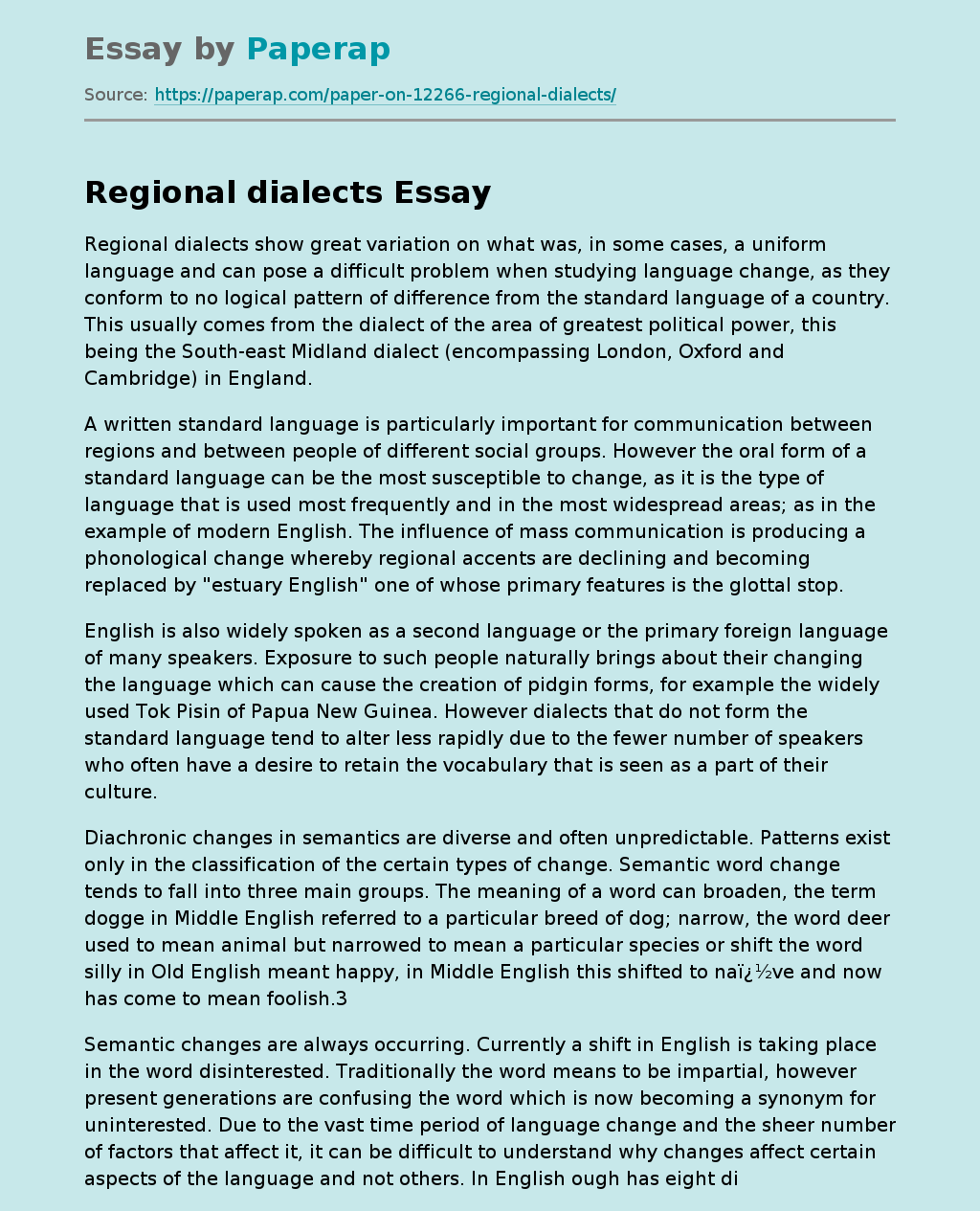Regional dialects
Regional dialects show great variation on what was, in some cases, a uniform language and can pose a difficult problem when studying language change, as they conform to no logical pattern of difference from the standard language of a country. This usually comes from the dialect of the area of greatest political power, this being the South-east Midland dialect (encompassing London, Oxford and Cambridge) in England.
A written standard language is particularly important for communication between regions and between people of different social groups.
However the oral form of a standard language can be the most susceptible to change, as it is the type of language that is used most frequently and in the most widespread areas; as in the example of modern English. The influence of mass communication is producing a phonological change whereby regional accents are declining and becoming replaced by “estuary English” one of whose primary features is the glottal stop.
English is also widely spoken as a second language or the primary foreign language of many speakers.
Exposure to such people naturally brings about their changing the language which can cause the creation of pidgin forms, for example the widely used Tok Pisin of Papua New Guinea. However dialects that do not form the standard language tend to alter less rapidly due to the fewer number of speakers who often have a desire to retain the vocabulary that is seen as a part of their culture.
Diachronic changes in semantics are diverse and often unpredictable. Patterns exist only in the classification of the certain types of change.
Semantic word change tends to fall into three main groups. The meaning of a word can broaden, the term dogge in Middle English referred to a particular breed of dog; narrow, the word deer used to mean animal but narrowed to mean a particular species or shift the word silly in Old English meant happy, in Middle English this shifted to na�ve and now has come to mean foolish.3
Semantic changes are always occurring. Currently a shift in English is taking place in the word disinterested. Traditionally the word means to be impartial, however present generations are confusing the word which is now becoming a synonym for uninterested. Due to the vast time period of language change and the sheer number of factors that affect it, it can be difficult to understand why changes affect certain aspects of the language and not others. In English ough has eight different recognised forms of pronunciation. In addition to this, in Chinese for example, the oral forms of a language can change out of all recognition to become a different language yet at the same time written form can remain mutually intelligible. This shows that speech and written language are two very different areas that can change in different ways, and that these changes can happen independently of each other.
Changes in language can also occur due to individual speakers. It is true that parole, according to F. de Sassure, is the way in which an individual produces their language; however these changes can be perpetuated permanently when new generations adopt traits from their parents by “creative copying,” so that gradually, a language changes imperceptibly to a current speaker, unless it is compared with the language of previous generations. For example the differences in lexicon and even intonation of voice heard on film footage of the First World War and even as recently as the Fifties. Analogical formations can also become accepted into standard language, in Old English the -s ending was only one of many plurals but is now standard.
As mentioned previously, social factors such as the development of technology and changes in education, along with words that come into (and out of) fashion can affect languages, particularly within the younger generations, without any apparent predictability. Certain buzz words change semantically from one generation to become the latest word for ‘cool,’ ultimately, these trends rely on the individual to decide whether to use and pass on such words so that they become embedded in the lexicon.
It must be said that the unpredictability of language change caused by the influence of history and social factors, can only show certain tendencies for changes that happen rather than them complying to rigid rules. Even though patterns can be analysed in diachronic linguistics, this is simply a demonstration of what has occurred as opposed to an explanation as to why the change has happened. The diversity of language change is so great, and on the whole unpredictable that it can not be submitted to complete and generalised analysis.
Regional dialects. (2018, Jan 09). Retrieved from https://paperap.com/paper-on-12266-regional-dialects/

